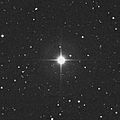51 Pegasi facts for kids
51 Pegasi is a star that is much like our own Sun. It is found about 50 light-years away from Earth. You can find it in the constellation called Pegasus. In 1995, scientists made a huge discovery. They found that 51 Pegasi was the first Sun-like star, besides our Sun, to have a planet orbiting it. This was a very exciting moment in astronomy!
Contents
Discovering a New World
The discovery of this exoplanet was announced on October 6, 1995. Two scientists, Michel Mayor and Didier Queloz, shared the news. They found the planet using a special method called the radial velocity method. This work was done at the Observatoire de Haute-Provence, using a tool called the ELODIE spectrograph. This tool helps find planets outside our Solar System.
After this first announcement, more proof came quickly. On October 12, 1995, Dr. Geoffrey Marcy and Dr. R. Paul Butler confirmed the discovery. They used the Hamilton Spectrograph at the Lick Observatory in California. Their work helped show that this new planet truly existed.
About the Star 51 Pegasi
The star 51 Pegasi looks fairly bright from Earth. It has an apparent brightness of 5.49. This means you can see it with binoculars. If it's very dark outside, you might even see it with your own eyes.
51 Pegasi is a yellow dwarf star. This type of star is similar to our Sun. Scientists think it is about 7.5 billion years old. This makes it a bit older than our Sun. 51 Pegasi is also a little bit bigger than our Sun, about 4-6% more massive. It also has more metal content than our Sun. However, it is slowly using up its hydrogen fuel.
In 1996, astronomers Baliunas, Sokoloff, and Soon studied the planet orbiting 51 Pegasi. They calculated that the planet, named 51 Pegasi b, takes 37 days to go around its star.
Meet the Planet 51 Pegasi b
51 Pegasi b was the very first planet found orbiting 51 Pegasi. If more planets are found around this star, they would be named 51 Pegasi c, 51 Pegasi d, and so on. People have also given 51 Pegasi b an informal name: Bellerophon.
After its discovery, many teams of scientists studied this planet. They learned more about its features. For example, they found that it orbits very close to its star. Because it's so close, its estimated temperature is around 1200 Celsius. They also found that its minimum mass is about half the mass of Jupiter.
Images for kids
-
Artist impression of the exoplanet 51 Pegasi b
See also
 In Spanish: Helvetios (estrella) para niños
In Spanish: Helvetios (estrella) para niños




